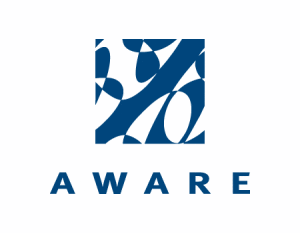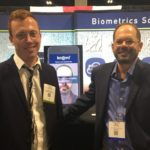
Aware, Inc. has long been a heavy-hitter in the biometric security industry, but it has had a particularly eventful year in 2018. The company won a huge contract from the UK Home Office this summer to work on an important biometric services project that will have applications in border control, immigration, and law enforcement. And in September, Knomi, Aware’s mobile biometric authentication platform, became one of the few authenticator products to attain Level 1 certification against the FIDO Alliance’s UAF 1.1 standard.
Catching up with Aware’s Marketing and Product VP, David Benini, after an earlier meeting at this year’s Money20/20 event in Las Vegas, FindBiometrics President Peter O’Neill started their latest interview on these topics, asking Benini to elaborate on Knomi’s advantages, FIDO UAF, and Aware’s government work. From there, the two discussed growth opportunities in other verticals, the rise of facial recognition and machine learning, and the importance of standards testing. It’s discussion that touched on some of the most salient topics in today’s biometrics industry, and well worth a closer look:
Read our full interview with David Benini, Vice President Marketing and Product, Aware:
Peter O’Neill, President, FindBiometrics: David, you and I had a chance to meet at Money20/20 in Las Vegas in October and there you were talking about your Knomi platform. Can you please tell our readers about this multimodal biometric authentication product?
David Benini, VP Marketing & Product, Aware Inc.: Sure, thank you Peter. It was great to see you in Las Vegas at Money20/20.
That’s right, Knomi is a mobile biometric authentication framework. We focus on providing high-performance biometric algorithms, including matching and liveness detection, in a way that does not sacrifice user experience. We are currently offering face, voice, and keystroke modalities, as well as multimodal versions of those, which include Face+Voice and Face+Keystroke. We’re capturing those modalities simultaneously and also applying various liveness detection functions, including active and passive mechanisms for both facial and voice. Knomi supports a FIDO Certified, device-centric architecture as well as a server-based architecture that processes and stores biometrics securely on the server.
A key design feature of the Knomi framework is to enable biometrics to be easily integrated into other identity and authentication platforms, providing the algorithm functions but not necessarily the complete suite of authentication functionality that an authentication server might offer. For example, we integrate with various identity server products on the market to enable them with biometrics.
Peter O’Neill, President, FindBiometrics: You mentioned a couple of very interesting things there, David. You and I have both been in this industry for quite some time and have had conversations in the past about two areas that I’d just like to delve into a little bit deeper. One is the growth of multimodal, and maybe you could just tell us what’s driving all of that, and the second is liveness and why that is so critical these days. Could you expand a little bit on both of those for us?
David Benini, VP Marketing & Product, Aware Inc.: The requirements for biometric authentication for a given application lie on a spectrum between convenience and security; some applications require higher security and can sacrifice a bit in terms of friction, in contrast to consumer-facing applications, where user experience and convenience are of paramount importance. So, our goal is to optimize the convenience and the security the best that we can for a given application. Facial biometrics, for example, are ideal for mobile biometric authentication because the matching performance is very strong but also convenient and familiar; that’s why face is an ideal choice for mobile authentication. However, there are trillions of digital facial images out there that can potentially be used for spoofing, without any remediating liveness detection functionality, so facial biometrics are a non-starter without strong liveness and spoof-detection functionality.
Multimodal is interesting here because we can get such a boost in both matching performance and also liveness detection when we add additional modalities, without necessarily degrading the user experience.
For example, when we add voice to facial biometrics, we can do that in a way that doesn’t take any more time for the user because we’re capturing them simultaneously, and we get roughly an order-of-magnitude improvement in the matching performance. At the same time, we’re making it much more complicated for a fraudster to spoof. Adding voice also adds an additional layer of voice-based liveness detection. So the goal with multimodality is to improve the security without taking away from the user experience.
Peter O’Neill, President, FindBiometrics: Just before we leave the Knomi product, you mentioned FIDO. So I understand that Knomi is FIDO UAF 1.1 Level 1 certified, is that correct?
David Benini, VP Marketing & Product, Aware Inc.: Yes, of the hundreds of FIDO Certified products, Knomi authenticators are among a small handful of authenticators that were first to certify against UAF 1.1 with Level 1 security.
Peter O’Neill, President, FindBiometrics: Now, the month before, in September, we met you at the FedID government conference in Tampa where you were focusing on your BioSP product line for law enforcement and government, etc. You have a very large contract in the UK – can you please tell us about your focus on government solutions, but especially about this UK opportunity?
David Benini, VP Marketing & Product, Aware Inc.: Aware has one foot in the public sector realm—providing products for what you might call our more traditional public-sector applications of biometrics such as law enforcement, border management, and defense—and one foot in the nascent but higher-growth area of mobile authentication, currently being adopted by the financial services industry and others.
We have a product called Biometric Services Platform (BioSP), which is the market-leading biometric services platform on the market. It’s a mature product, deployed in upwards of one hundred systems as the central middleware and workflow platform, and used like an enterprise service bus that integrates different systems and performs advanced server-based functionality. It’s operating throughout the US government and several governments around the world.
One of 2018’s larger projects has been in the UK, where BioSP is being used by the UK Home Office as a hub between different law enforcement entities to facilitate the provision of biometrics services that enhance cooperation between different law enforcement efforts. That is a typical of how BioSP is used in so many systems around the world.
Peter O’Neill, President, FindBiometrics: You mentioned that you are participating in both emerging and established markets, but beyond financial services and government, where do you see the growth over the next few years? I know in the past we’ve spoken of verticals like healthcare, etc. – where do you see the growth happening?
David Benini, VP Marketing & Product, Aware Inc.: We’re certainly seeing uptake by banks, and I think that is well known. Going forward, we will see increased adoption for both enterprise security and in healthcare for patient identification. Misidentification of patients is a serious problem, particularly in regions where identity credentials are less common, and we do have customers who are using our solutions for patient ID.
Another area that I think will see continued growth is workforce time and attendance, in large part because of what’s happening in mobile biometrics. Mobile biometrics are a natural fit for this application, and standards like FIDO make it particularly attractive for some of these new applications to look at biometrics as a way to solve their identity challenges.
Peter O’Neill, President, FindBiometrics: Over the past five years, our industry has seen a lot of change, it’s all been great, in large part thanks to Apple, and as you suggested, mobility has been a big driver in all of this. If you were to look five years down the road, are we ready to take it to the next level? What are some of the challenges you think we might experience trying to move our industry forward?
David Benini, VP Marketing & Product, Aware Inc.: Just five years ago, folks were somewhat down on facial recognition; it was kind of the third horse behind fingerprint and iris. But as we see in the recent NIST FRVT report, the performance of facial biometrics has improved dramatically in a relatively short time, thanks in large part to machine learning. I think you could argue now that it’s the leading modality for authentication.
But without the types of independent biometric algorithm performance testing that few others than NIST perform, we’d all be in the dark about how they are actually behaving. It is notoriously difficult to test biometric algorithms in an independent and meaningful way across all the different use cases and environments. For adoption to broaden, we will need to continue to improve efforts to measure and report biometric algorithm performance, not just for matching but also spoof detection.
Peter O’Neill, President, FindBiometrics: David, as always, it’s been a pleasure speaking with you. Again, I’ve known you for many years in this industry and it’s a great time to be in this space and we certainly see your company as one of the leaders, so thanks again for carving out some time for us today.
David Benini, VP Marketing & Product, Aware Inc.: Thank you, Peter. Great to talk to you as well.






![MWC 2019: Aware’s International Sales Director Talks Knomi and a Big Banking Client [Audio]](https://idtechwire.com/wp-content/uploads/MWC19-Aware-1-e1551388883736-150x150.png)
Follow Us